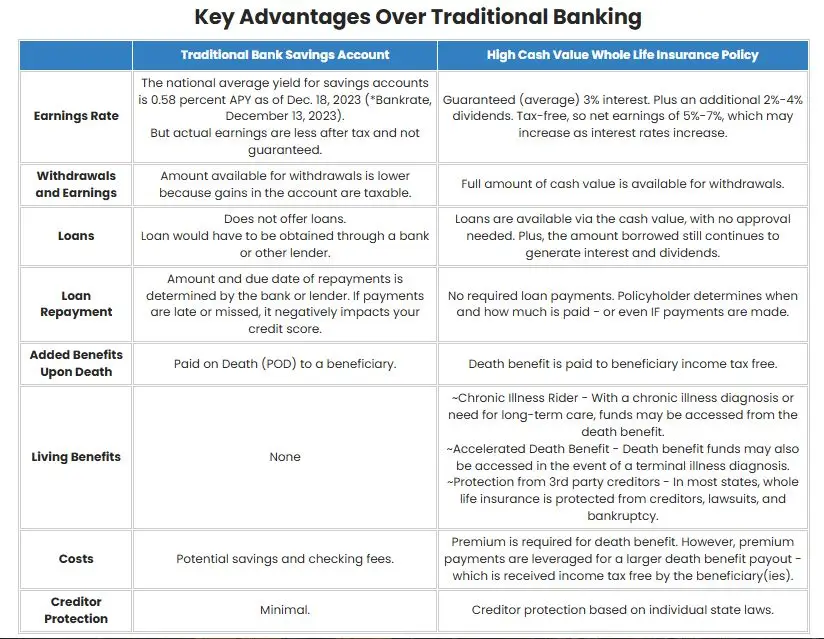All Categories
Featured
Table of Contents
Okay, to be reasonable you're truly "financial with an insurance provider" as opposed to "financial on yourself", but that concept is not as easy to sell. Why the term "limitless" financial? The idea is to have your money working in numerous places at the same time, as opposed to in a solitary area. It's a little bit like the concept of purchasing a residence with cash, after that obtaining against your home and placing the cash to function in an additional financial investment.
Some people like to chat concerning the "rate of money", which generally indicates the same point. That does not indicate there is absolutely nothing beneficial to this concept once you obtain past the marketing.
The entire life insurance coverage industry is pestered by excessively expensive insurance, huge payments, unethical sales methods, reduced rates of return, and inadequately educated customers and salesmen. If you want to "Bank on Yourself", you're going to have to wade right into this industry and really purchase whole life insurance coverage. There is no replacement.
The warranties fundamental in this product are vital to its function. You can borrow against many kinds of cash worth life insurance coverage, yet you should not "financial institution" with them. As you acquire an entire life insurance plan to "bank" with, bear in mind that this is a completely separate section of your economic plan from the life insurance coverage section.
Get a large fat term life insurance policy policy to do that. As you will certainly see below, your "Infinite Banking" policy truly is not mosting likely to dependably offer this vital economic function. An additional issue with the reality that IB/BOY/LEAP counts, at its core, on an entire life policy is that it can make getting a plan troublesome for most of those interested in doing so.
Infinite Banking Illustration
Hazardous leisure activities such as SCUBA diving, rock climbing, sky diving, or flying likewise do not blend well with life insurance policy items. The IB/BOY/LEAP supporters (salesmen?) have a workaround for youbuy the policy on somebody else! That might work out fine, because the factor of the plan is not the fatality benefit, yet keep in mind that acquiring a policy on small kids is extra costly than it must be since they are normally underwritten at a "common" rate instead than a liked one.

A lot of policies are structured to do one of 2 things. The commission on a whole life insurance plan is 50-110% of the first year's premium. Sometimes policies are structured to make the most of the death benefit for the premiums paid.
With an IB/BOY/LEAP plan, your objective is not to take full advantage of the survivor benefit per buck in costs paid. Your goal is to make the most of the cash worth per dollar in premium paid. The price of return on the policy is really crucial. One of the very best means to maximize that aspect is to obtain as much cash as possible right into the plan.
The finest method to boost the price of return of a policy is to have a fairly small "base policy", and afterwards put more cash money into it with "paid-up additions". Rather than asking "How little can I place in to obtain a specific fatality advantage?" the concern ends up being "Just how much can I lawfully took into the policy?" With even more cash money in the plan, there is even more cash money value left after the expenses of the survivor benefit are paid.
A fringe benefit of a paid-up addition over a normal premium is that the commission price is reduced (like 3-4% as opposed to 50-110%) on paid-up enhancements than the base plan. The much less you pay in payment, the greater your rate of return. The price of return on your money worth is still going to be adverse for some time, like all cash worth insurance plan.
Many insurance companies only use "straight recognition" financings. With a straight recognition car loan, if you borrow out $50K, the returns price used to the cash money value each year just uses to the $150K left in the policy.
Infinite Banking Video
With a non-direct recognition lending, the business still pays the very same dividend, whether you have "obtained the cash out" (practically versus) the plan or otherwise. Crazy? Why would certainly they do that? Who recognizes? But they do. Frequently this function is matched with some less advantageous element of the plan, such as a reduced dividend price than you could get from a plan with straight acknowledgment fundings (how to become your own bank with life insurance).
The business do not have a resource of magic cost-free money, so what they offer in one area in the plan have to be drawn from one more area. However if it is drawn from an attribute you care less around and take into a feature you care a lot more around, that is a good point for you.
There is another essential feature, normally called "clean loans". While it is excellent to still have dividends paid on money you have actually secured of the plan, you still have to pay rate of interest on that financing. If the reward rate is 4% and the loan is charging 8%, you're not specifically appearing ahead.
With a laundry finance, your funding rates of interest coincides as the reward rate on the plan. While you are paying 5% interest on the car loan, that interest is entirely balanced out by the 5% dividend on the finance. In that respect, it acts simply like you took out the cash from a financial institution account.

5%-5% = 0%-0%. Same same. Thus, you are currently "financial on yourself." Without all three of these factors, this policy simply is not going to work extremely well for IB/BOY/LEAP. The largest problem with IB/BOY/LEAP is individuals pushing it. Almost all of them stand to make money from you buying right into this principle.
In truth, there are lots of insurance coverage agents speaking about IB/BOY/LEAP as an attribute of whole life who are not in fact marketing plans with the necessary functions to do it! The trouble is that those that understand the idea best have an enormous dispute of passion and typically pump up the advantages of the concept (and the underlying plan).
Become My Own Bank
You must compare loaning versus your policy to taking out cash from your savings account. Return to the start. When you have absolutely nothing. No deposit. No cash in investments. No money in cash money value life insurance policy. You are confronted with a selection. You can place the cash in the financial institution, you can invest it, or you can buy an IB/BOY/LEAP plan.
It grows as the account pays rate of interest. You pay taxes on the interest yearly. When it comes time to buy the boat, you withdraw the cash and get the boat. After that you can save some more money and put it back in the banking account to start to make rate of interest once more.
It expands throughout the years with capital gains, returns, rental fees, and so on. A few of that earnings is exhausted as you accompany. When it comes time to purchase the boat, you market the financial investment and pay tax obligations on your long-term capital gains. You can conserve some even more money and acquire some more financial investments.
The cash money value not made use of to spend for insurance and commissions grows throughout the years at the dividend rate without tax drag. It begins out with adverse returns, yet hopefully by year 5 or so has recovered cost and is expanding at the returns price. When you go to acquire the watercraft, you borrow against the plan tax-free.
Ibc Infinite Banking Concept
As you pay it back, the cash you repaid begins expanding again at the returns price. Those all work quite similarly and you can contrast the after-tax prices of return. The fourth option, nonetheless, works extremely in different ways. You do not save any money nor acquire any type of investment for many years.
They run your debt and give you a finance. You pay rate of interest on the borrowed money to the financial institution up until the financing is settled. When it is paid off, you have a virtually pointless watercraft and no money. As you can see, that is nothing like the very first three alternatives.
Latest Posts
Become Your Own Bank Today! It's A Strategy That Many Have ...
How You Can Become Your Own Bank
How Can I Be My Own Bank